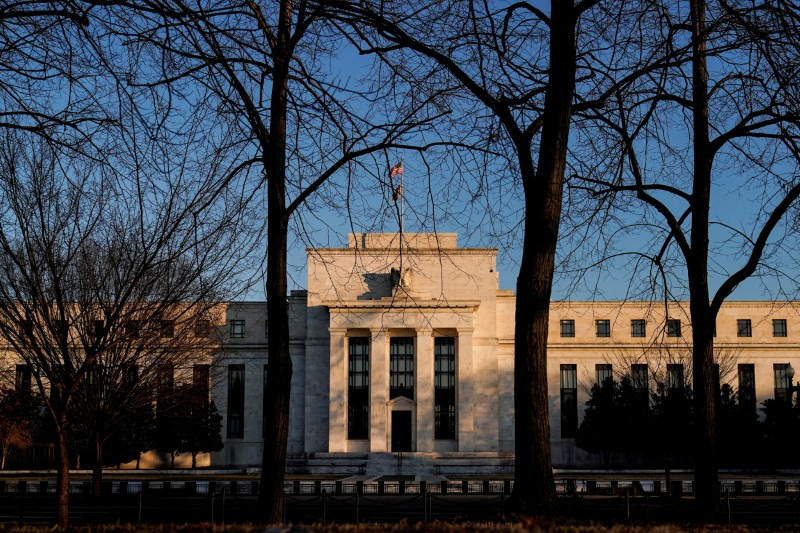Jobs report fuels Treasury yield surge as markets brace for 5% threshold
By Davide Barbuscia
NEW YORK (Reuters) -A recent surge in U.S. Treasury yields may gain even more momentum after a strong jobs report reinforced expectations that interest rates will stay high for longer and raised the spectre of benchmark 10-year yields hitting 5% — a level that some fear could rattle broader markets.
Friday’s jobs report revealed that employers added 256,000 jobs in December, well above economists’ forecasts, while the unemployment rate dropped, bolstering market expectations that the Federal Reserve will maintain elevated interest rates to curb economic overheating.
That news dashed investors' hopes for some respite from a sharp rise in Treasury yields that has wobbled stocks since the beginning of the year. The data also re-ignited concerns about inflation, which remains stubbornly above the Fed's 2% target.
"The report was obviously negative for inflation," said Felipe Villarroel, partner and portfolio manager at TwentyFour Asset Management. "This is definitely not an economy that is decelerating."
Traders are now expecting the central bank will wait until at least June to reduce its policy rate. Before the jobs data, they were betting the Fed would cut rates as early as May with about a 50% chance of a second cut before year end.
Both J.P. Morgan and Goldman Sachs pushed their Fed rate cut forecast to June, having earlier projected a cut in March.
Concerns over a rebound in inflation have also begun to raise the prospect that the Fed's next move could be a hike - a scenario that would have been unthinkable a few months ago when investors expected interest rates would have declined to about 2.8% by the end of this year. They are now at 4.25%-4.5%.
"Our base case has the Fed on an extended hold. But we think the risks for the next move are skewed toward a hike," analysts at BofA Securities said in a note on Friday.
Longer-dated U.S. Treasury yields, which move inversely to prices, jumped to their highest levels since November 2023, with the 10-year hitting a high of 4.79%. Yields have gained 20 basis points since the beginning of the year amid a global government bonds selloff that has hit UK government bonds particularly hard, pushing 30-year gilt yields to their highest since 1998.
Many in the bond market fear further weakness lies ahead, as fiscal and trade policies under the upcoming Donald Trump administration could lead to more Treasury issuance and a rebound in inflation. A BMO Capital Markets client survey before the jobs report showed 69% of respondents expect 10-year yields will test 5% at some point this year.
Next (LON:NXT ) week’s economic reports will feature December’s producer and consumer price inflation data, which could be key for the direction of yields.
The yield curve comparing two-year with 10-year yields has steepened in recent weeks because 10-year yields have been rising while shorter-dated ones have remained flat, a so-called "bear steepening" dynamic, bad for long-term bond prices, indicating the market expects interest rates to remain high due to ongoing resilience in the economy.
But that could change should inflation rise again, warned Jack McIntyre, a portfolio manager at Brandywine Global.
"Look for Treasury market to shift to a bear flattening from its recent bear steepening trajectory," he said in a note. Bear flattening occurs when short-term interest rates rise faster than long-term interest rates, which can happen when investors anticipate central banks will increase interest rates.
Outside of bonds, rising U.S. Treasury yields could dampen investor interest in stocks and other high-risk assets by tightening financial conditions and increasing borrowing costs for businesses and individuals.
Higher yields can also improve the attractiveness of bonds against equities, "with 5% still seen as a trigger point for asset allocation shifts," said BNY in a recent note.
In late 2023, stocks declined when benchmark 10-year yields reached 5% for the first time since 2007, and while they largely shrugged off the increase in yields late last year as the move was linked to an improved economy, stocks tumbled this week as upbeat economic data propelled yields higher.
The S&P 500 was down 1% on Friday.
"The 10-year yield will remain above 4% this year and as a result it could be quite challenging for the stock market," said Sam Stovall, chief investment strategist of CFRA Research, after the jobs data. "We started the year on the wrong foot."
Source: Investing.com
